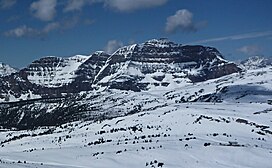| The Monarch | |
|---|---|
 The Monarch | |
| Highest point | |
| Elevation | 2,895 m (9,498 ft) [1] [a] |
| Prominence | 555 m (1,821 ft) [4] |
| Parent peak | Mount Brett (2984 m) [4] |
| Listing | Mountains of British Columbia |
| Coordinates | 51°03′05″N115°50′54″W / 51.05139°N 115.84833°W [5] |
| Geography | |
 | |
| Interactive map of The Monarch | |
| Country | Canada |
| Province | British Columbia |
| District | Kootenay Land District |
| Parent range | Ball Range, [1] Canadian Rockies |
| Topo map | NTS 82O4 Banff [5] |
| Geology | |
| Rock age | Cambrian |
| Rock type | sedimentary rock |
| Climbing | |
| First ascent | 1913 Conrad Kain with Interprovincial Boundary Survey [4] |
| Easiest route | Moderate Scramble [2] |
The Monarch is a 2,895-metre (9,498-foot) mountain summit located in the Ball Range of the Canadian Rockies in British Columbia, Canada. The Monarch is situated on the boundary between Kootenay National Park and Mount Assiniboine Provincial Park, [6] four kilometres to the west side of the Continental Divide. Although not visible from roads, The Monarch is a prominent feature seen from the slopes above Sunshine Village ski resort. Its nearest higher peak is Mount Bourgeau, 10.35 km (6.43 mi) to the north-northeast. [1]



